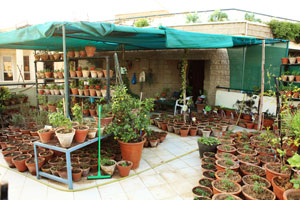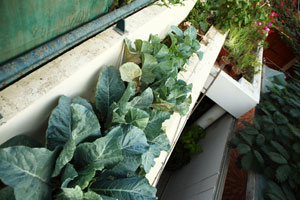The Greens Keeper
By Amna Khalique | People | Profile | Published 14 years ago
Caring for plants is extremely rewarding, especially when they flower or bear fruit. At the same time it can also be extremely tedious when you’re a new enthusiast, like me. When do you know you are over-watering or when to add fertiliser and when to stop because, apparently, there is such a thing as over-fertilising. What plants go in the shade and when to move them when it gets so windy that the leaves begin to droop?
Earlier this year, when I visited the annual flower show, I was overwhelmed by the variety of shrubs, perennials, flowering plants, cacti and so much more. But there was one stall that was particularly endearing, called Mom’s Garden. The owner, Yasmin Raza, was selling seeds and full-grown plants of herbs (parsley, lemon grass, thyme, rosemary) and vegetables (eggplant, lemon, tomato, cherry tomato, celery). People were flocking to the stall in droves, buying herbs and seeds for their vegetable patch, and even wanting to get growing tips from Raza. In the midst of this pandemonium, I somehow managed to buy a couple of plants, which regretfully died a few weeks later.
Despondent but still wanting to give my inner-gardener another shot, I decided to seek Yasmin Raza to gain some wisdom on planting and growing. Raza has been growing her own vegetables for as long as she can remember. “My husband was in the army and we would live in the cantonment houses where there was so much space to grow plants. I started out by growing onions, garlic and vegetables that you use on a regular basis.”

Yasmin Raza
Now this love for gardening has developed into a full-time hobby. Raza moved to Karachi about nine years ago, after living in Rawalpindi, Quetta and a few more cities. Her passion for growing plants is obvious as soon as you enter her house — right in the middle is a small atrium with floor-to-ceiling glass windows. Suspended from wooden bars across the length of the atrium are rows and rows of orchids over small shrubs, pebbles and a small pond. Upstairs, her terrace has been converted into a mini nursery. Dozens of planters of all sizes with newly-sowed seeds have small, labelled cards to show which vegetable or herb has been planted. These almost cover the floor area of the terrace while the smaller planters are stacked on steel shelves with green netting covering one side of the shelf, “to keep out the crows,” Raza explains. Crows seem to be a problem when planting new seeds and so do mice. “Just yesterday we found five dead mice. They can be such a problem; they ate up my entire harvest of cabbage. I was waiting for them to ripen and the next day, it was all gone.” But that doesn’t deter her from planting more vegetables. Sometimes, it’s not the mice or crows but, in fact, the seeds. “This season I haven’t been able to grow chillies. I just replanted the seeds again,” Raza tells me. On the flip side, last year when she grew strawberries, the plants flourished and bore so much fruit that they sent dozens to friends and family.
Raza spends a minimum of two hours each morning on the terrace, caring for her plants. There is even a small makeshift office, as she calls it, with two garden chairs and a table. It also has a phone line and a wall clock hanging behind it. “I’m here every day from 9 a.m. to about 11 p.m. I’ve set up office here so it’s easier for me to organise.”

Photo: Danish Khan
The space around the terrace and roof has been used effectively. All along the boundary wall, on the outer ledge is a kiyari (flower bed) where she grows tomatoes, rocket and cabbage. Right now, tomatoes as green as Granny Smith apples were on the stalks, their weight almost dropping them to the ground. Just a couple of weeks to go and Raza will have a full harvest of tomatoes ready. “These are so fresh and delicious that you can even eat them raw,” she says, as she points out the different varieties of tomatoes.
Her gardener, Ashraf, is extremely passionate about the vegetables and herbs. He animatedly explains how to re-plant some of the seedlings that I’m taking home with me. His hands and nails have a layer of soil in and on them but that obviously doesn’t bother him. “People from the village just know how to plant. It’s in our blood, we grew up around it,” he says as he takes an agile leap onto the outer ledge of the wall to get me some rocket leaves. As he walks back and forth, enlightening me on how local rocket smells and looks different from the imported kind, my palms begin to sweat just looking at him so close to the edge. I ask him if he’s safe. He just laughs and continues with his little lecture.

Photo: Danish Khan
Raza, who does this purely for leisure, doesn’t even sell the seedlings on a regular basis. Her penchant for planting and growing is mostly self-taught and by reading gardening books. She researches online but feels that the information available isn’t suitable for local conditions so anything grown here is mostly through trial and error. The seeds that she sold at the flower show last year came with complete instructions and pointers on planting and growing. Ashraf has been working with her for the past five years and is just as dedicated as she is. “In fact, he might have been more excited about the flower show than I was. He came up with ideas on what to sell and how to sell it.”
With at least a dozen plants of each kind, I wonder what happens when all of them bear fruit? Does it not go to waste? “I give them away to my friends and neighbours. I don’t want to make it into a business; last year was my first time at the flower show. I have stipulated days when people can contact me so that it doesn’t get overwhelming. What I’m trying to do is encourage other women to at least try growing something. A lot of women who aren’t working don’t have much to do all day. They should at least give this a try and see how relaxing and rewarding this experience can be. It’s such a wonderful feeling, to be able to eat what you grow in your garden,” says Raza.


